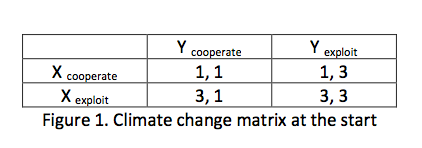Is Climate Change a Prisoner's Dilemma or a Stag Hunt?
Welcome back, gamers! This installment of the project on game theory and climate change will take some time to outline basic concepts about game theory and apply them to the three “games” described in the previous Note. To recap, we’ll be considering scenarios involving a hypothetical negotiation between West Virginia and Kentucky to curb emissions, a similar negotiation between the United States and China, and finally the future actions of the major expected signatories of the Paris climate agreement.
In each scenario there are a collection of actions that each actor can take. We’ll need to simplify a lot of these actions in the early going into approving and enacting a climate policy or deciding to continue business as usual. Here, in the context of the game, it makes sense to label the two strategies coordination and defection. There are, of course, infinite other possible strategies that may only differ by a dollar amount of spending or a single ton of emissions reduced. As the project goes on, hopefully we’ll be able to model these more accurately using some fancy statistics, but for now the two strategies are to coordinate or defect. The conjunction of each of these strategies with another actor’s corresponding strategy will produce an outcome for each actor.
Recommended: Why Americans Are So Sensitive to Harm
In all scenarios, the five main considerations are the value of environmental resources, the future costs of climate change, the degree to which emissions policies can affect those future costs, how much those policies cost, and how much each actor can actually afford to spend or lose. There are some other considerations that can act as minor variables, such as the often considerable “inertia” involved in adopting new technologies and policies, the externalities of emissions policies (i.e. reducing smog in China or water pollution in West Virginia), elections and shifting public opinion, and the changing immediacy of the costs of climate change. But in all, each of these considerations can be collapsed into two categories that revolve around a set of outputs: costs and payoffs.

Reader Max Malikov shared with me some useful examples for visualizing the climate game. The first figure shows what a short-term assessment of climate policy might look like if there was no real threat to the environment. Acting to protect the environment is costly and has a limited benefit that is far outweighed by the benefit of simply using the environmental resources at maximum efficiency. So, in the example of Kentucky and West Virginia defection would mean both states opening up as many coal plants as possible to maximize energy output and profits. Neither state has an incentive to help protect the environment, especially in a market where the two neighbors compete against each other for jobs and productivity.

Read more from The Atlantic:
This article was originally published on The Atlantic.
